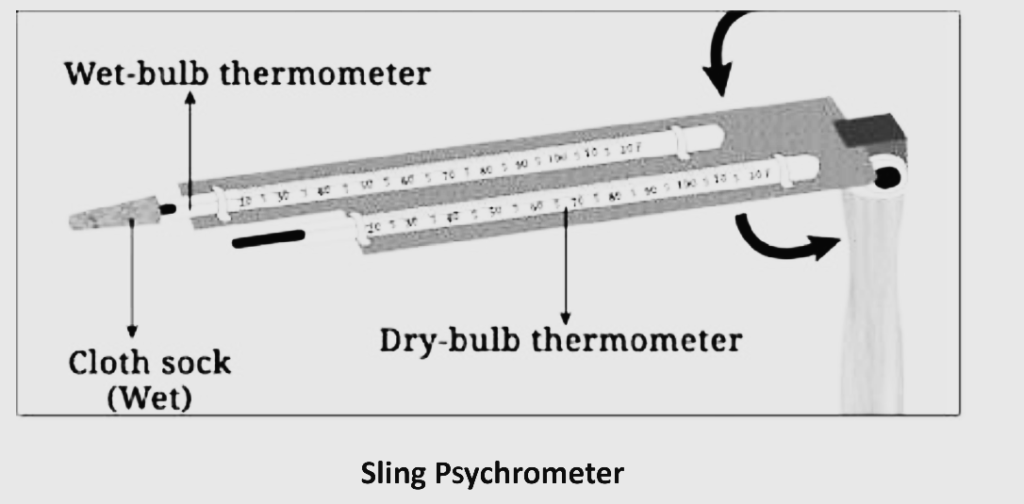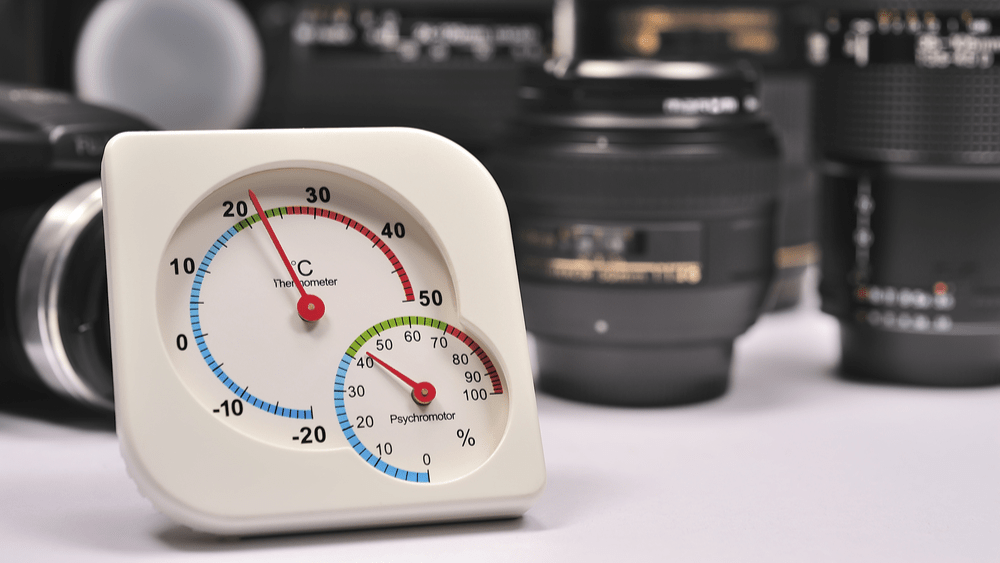Aim: To determine Relative humidity (% RH) and dew point temperature using a Sling thermometer
Requirement:
Chemicals: Distilled water
Apparatus/ Instrument: Cotton wick, Sling’s thermometer ( Psychrometer).
Principle Relative humidity
A sling Psychrometer is used to measure both the dry bulb and wet bulb temperatures at a time. These temperatures are a measure of humidity content in the air. This instrument works on the principle of evaporation of water. When water on a surface evaporates, it extracts a significant amount of heat from it, cooling the surface down. This is how sweat is able to cool down our body and skin when it gets hot. However, air can only hold a limited amount of water, ager which it becomes saturated. This can be observed in beaches and coastal regions, where, since the air is humid, the sweat from our bodies doesn’t evaporate easily. The psychrometer is designed to make use of both these facts, to help us measure the humidity of the air.

Description Sling psychrometer
- The instrument frame carrying the thermometer is covered by a glass casing.
- A swivel handle is attached to the frame-glass casing – thermometer arrangement to ensure that the air at the wet bulb is always in immediate contact with the wet wick.
- When a thermometer bulb is directly exposed to an air-water vapour mixture, the temperature indicated by the thermometer is the dry-bulb temperature.
- When a thermometer bulb is covered by a constantly wet wick and if the bulb covered by the wet wick is exposed to an air-water vapour mixture, the temperature indicated by the thermometer is the wet bulb temperature.
- The instrument frame holds the thermometers. One mercury-in-glass thermometer whose sensing bulb is bare to directly contact the air and to measure the temperature is called the dry‐bulb temperature.
- One mercury-in-glass thermometer whose sensing bulb is covered with a cotton or muslin wick made wet with pure water. This sensing bulb covered with a cotton wick moistened is made to contact the air and the temperature indicated by this thermometer is called as the wet bulb‐thermometer.
The parameters on a psychrometric chart are:
- Dry bulb temperature (DBT): DBT of an air sample, as determined by an ordinary thermometer. It is typically plotted as the abscissa (horizontal axis) of the graph.
- Wet bulb temperature (WBT): WBT is that of an air sample, ager it has passed through a constant pressure, ideal, adiabatic saturation process. That is, ager the air has passed over a large surface of liquid water in an insulated channel. This temperature is indicated by diagonal lines on the chart.
- Humidity ratio: It is the proportion of the mass of water vapour per unit mass of dry air at the given conditions. It is also known as moisture content or mixing ratio. It is typically plotted as the ordinate (vertical axis) of the graph.
- Specific volume: It is the volume of the mixture (dry air plus the water vapour) containing one unit of mass of “dry air”
- Dew point temperature: DPT is the temperature at which a moist air sample at the same pressure would reach water vapour “saturation”. At this point, further removal of heat would result in water vapour condensing into liquid water fog. This temperature is shown as horizontal lines on the chart.
- Enthalpy: It is the sum of the internal(heat) energy of the moist air in question, including the heat of the air and water vapour within. Enthalpy is indicated by diagonal lines on the chart.
- Relative humidity: RH is the ratio of the mole fraction of water vapour to the moles’ fraction of saturated moist air at the same temperature and pressure. RH is dimensionless and is usually expressed as a percentage. Lines of contrast RH reflect the physics of air and water; they are determined via experimental measurement. Lines of constant relative humidity are shown as exponential lines on the psychrometric chart. The line at 100% is referred to as the saturation line.
- Moisture content: This is also known as humidity ratio and is usually designated as W. It is the proportion of the mass of water vapour per unit mass of dry air. The humidity ratio is dimensionless, but in the US it is usually expressed as pounds of moisture per pound of dry air, elsewhere it may be expressed as pounds per kilogram of dry air or as a percentage. The moisture content is on the vertical axis of the chart.

Application of Sling Psychrometer/ thermometer
- It is used for checking humidity levels in air-conditioned rooms and installations.
- It is used to set and check the hair hygrometer.
- It is used in the measurement range of 0 to 100%RH.
- It is used for measuring wet bulb temperature between 0ºC to180ºC.
Procedure:
- In order to measure the dry bulb and wet bulb temperature, the Psychrometer frame – glass covering – thermometer arrangement is rotated at 5m/s to10m/s to get the necessary air motion.
- Note: An important condition is that correct/accurate measurement of wet bulb temperature is obtained only if air moves with a velocity around the wet wick. In order to get this air velocity, the Psychrometer is rotated.
- The thermometer, whose bulb is bare, contacts the air and indicates the dry bulb temperature.
- At the same time, the thermometer whose bulb is covered with the wet wick comes in contact with the air and when this passes on the wet wick present on the bulb of the thermometer, the moisture present in the wick starts evaporating and a cooling effect is produced at the bulb. Now the temperature indicated by the thermometer is the wet bulb thermometer which will naturally be lesser than the dry bulb temperature.
- Note: If the Psychrometer is rotated for a short period, then the wet bulb temperature recorded will not be proper.
- Note: If the Psychrometer is rotated for a longer period, the wick will get dried soon and the wet bulb temperature will not be at its minimum value.
Step1: Pre‐preparation
Before using the psychrometer, it is advisable to perform an initial pre-preparation step, to ensure that you get accurate readings out of it. Basically, you have to ensure that both, the thermometers on the device are displaying the same initial reading so that the measurement commences from the same starting point. A good way to do this is to shake the psychrometer rapidly for about a minute.
Step2: Prepare the Wick
The device uses a wet bulb thermometer in addition to a normal (dry) one. You need to completely soak the wick/sock of the wet bulb thermometer in the water to prepare it for use.
Step3: Whirl the Psychrometer
Once you have readied your instrument by following the steps given above, you can start using it. You have to swing it around in circles for approximately a minute to allow the water from the wick to get evaporated into the surrounding air, and thus cool the wet-bulb thermometer.
Step 4: Take the Readings
Ager swinging it for a minute, note down the readings from both thermometers, starting first with the wet one.
Step 5: Calculate the Humidity
To calculate humidity, simply take the difference between the temperature values obtained in the previous step, and then refer to a psychrometric chart to know the humidity value.
Step 6: The horizontal line that passes through the point of intersection of wet bulb temp and dry bulb temperature on leG hand side of the chart( on100%RHline)reads dew point temperature.
Observation
- Dry bulb temperature: _____________ 0C
- Wet bulb temperature: _____________ 0C
Observation Table:
| Dry bulb temperature 0C | Wet bulb temperature 0C | % Relative humidity | Dew point temp. |
Calculation:
Using a Psychometric chart extrapolate the obtained dry and wet bulb temperature to read the % Relative humidity
Results & Discussion:
Relation between dry and wet bulb temperature and the % Relative humidity is obtained
Make sure you also check our other amazing Article on: How do you calculate loss of drying?
